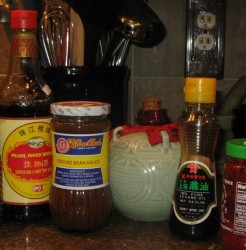Uber-Umami: Chinese Ground Bean Sauce
It is thick, salty and looks somewhat like peanut butter.
Everything you cook with it tastes better, but only if you don’t overdo it.
It is made from ground up fermented soybeans, rather like miso, but has a deeper, less salty flavor.
It is Chinese ground bean sauce, and is a “secret ingredient” in many very flavorful stir-fries, because it packs an oomfy wallup of umami flavor in every spoonful.
Remember umami–that “fifth taste,” for which receptors on our tongues have recently been discovered and confirmed? It is that savory, meaty taste that comes about from substances such as glutamate, other amino acids, and nucleotides. These substances, which are found naturally in meats, mushrooms, seaweed, fermented soybean products, fermented fish and some vegetables, enhance the natural flavors of foods, and as such have been utilized for centuries in the kitchens of Asia, long before the synthesis of monosodium glutamate and its overuse in the processed food industry.
Chinese ground bean sauce is produced similarly to Japanese miso, in that it is made from bacterially fermented soy beans, but to my tongue, it has a very different flavor profile. Most miso that I have tasted has a purer, less complex flavor, that has a very strong salty component, whereas the Chinese ground bean sauce has a deeper, more complex flavor profile, with a much more “meaty” taste. I have used miso to substitute it earlier in my experimentations with Chinese cooking, and have never been pleased with the results–the dishes just never tasted right to me, and I didn’t really understand why.
The reason is that one cannot simply exchange out a Chinese ingredient for a Japanese one and expect the dish to come out tasting authentically Chinese. It is just not going to happen. Just as I have learned to taste the difference between Japanese soy sauce and Chinese, so I can taste the difference between miso and Chinese fermented bean pastes.
These ingredients are analogues of each other; they perform similar functions in recipes in their respective cultures, but they do not taste the same, nor do they give the same results.
I have found a particularly good combination of ingredients to make a sauce for pork, gai lan and spiced dry tofu: marinate the meat in a bit of raw sugar, light soy sauce, shao hsing rice wine and cornstarch. Then, when cooking the aromatics, add a scant half teaspoon of chile garlic paste, and when you toss in the meat and tofu, add about a teaspoon and a half of the ground bean sauce. Do not add too much, or the dish will become overpoweringly salty. Sprinkle with a quarter teaspoon of the sugar. Add about a tablespoon of the wine and about another teaspoon of soy sauce to the wok after the meat browns on the bottom, and then when you add the gai lan to the wok, toss in a few tablespoons of chicken broth.
At the end, drizzle with a scant eighth teaspoon of toasted sesame oil.
The results are fantastic and subtle. The sauce is scant and glossy and clings to the meat, tofu and greens. The pork is incomparable in flavor–it is both sweet and savory, and salted perfectly. Something about the combination of ingredients makes it taste, if possible, “more porky,” as if the little slices are distillations of essential “porkness.”
If one does not eat pork, one can keep the tofu and substitute chicken. With chicken, I would use slightly less of the ground bean sauce, and a dash more of the wine. If one does not eat meat, keep the tofu and use instead of the meat either soaked dried shiitake mushrooms or fresh ones, marinated as for the pork. If you don’t want to add the chile garlic sauce because you want the flavor to be even more fundamental and simple, leave it out, but I think that the tiny bit I add gives the dish an amazing zing that is wonderful and should not be missed.
Other uses for Chinese ground bean sauce include adding a bit of it to ramen noodles to give them a lift, adding it to other sauces for stir fried or boiled noodle dishes, and using it in marinades for meat and fowl that is to be braised long and slow. The stuff lasts forever sealed up in its jar in the fridge and is inexpensive and well worth the trouble of seeking and and purchasing. I usually buy Koon Chun brand, with the yellow, blue and white label.
Pork, Tofu and Gai Lan with Ground Bean Sauce
Ingredients:
1/2 pound boneless pork loin, trimmed of most fat and cut into thin 1″X1/4″X1/8″ slices
1 teaspoon light soy sauce (I used Pearl River Bridge Brand)
1 1/2 tablespoons Shao Hsing wine
1/2 teaspoon raw or brown sugar
1 tablespoon cornstarch
3 tablespoons peanut oil
3 garlic cloves, sliced thinly
6 scallions, white and green parts only, sliced thinly on the bias
1 1/2″ cube fresh ginger, peeled and sliced thinly
1/4 teaspoon chile garlic paste
8 ounces spiced dry tofu, cut on the bias into slices similar to the pork slices
1 1/4-1 1/2 teaspoons ground bean sauce
1 tablespoon light soy sauce
2 tablespoons shao hsing wine
1 pound gai lan (Chinese broccoli), thick stems cut on the bias into bite sized pieces, and separated from the leaves
3 tablespoons chicken broth
leaves of the gai lan, cut into rough pieces
scant 1/8 teaspoon toasted sesame oil
Method:
Toss the pork with the next four ingredients and allow to marinate for ten to twenty minutes.
Heat wok on very high heat until it is smoking. Add peanut oil and allow to heat for another thirty seconds. Add garlic, scallion and ginger in a small pile, then put chile garlic paste on top. Allow to cook ten seconds, then stir fry until quite fragrant–about forty-five seconds to a minute.
Add meat in one layer, then put the tofu on top. Put the bean sauce on top of the tofu, and leave the meat to brown on the bottom undisturbed–about a minute or so. When you can see it is browned and smell it, start stir frying. When the pork is showing only 1/3 pink, add the soy sauce and wine and keep stir frying.
Add gai lan stems, and stir fry rapidly until very little pink is seen on the pork.
Add the gai lan leaves, and pour over it the chicken broth. Bring the meat, tofu and stems to the top of the leaves by stir frying, and stir and fry until the leaves wilt and become velvety.
Remove from heat and drizzle with sesame oil. Serve with steamed rice while still extremely hot.
15 Comments
RSS feed for comments on this post.
Sorry, the comment form is closed at this time.
Powered by WordPress. Graphics by Zak Kramer.
Design update by Daniel Trout.
Entries and comments feeds.







I’ll be looking out for this stuff and trying it.
One bad omission of mine a year ago when I first put together the herbs and spices material that I’m slowly uploading to my site was to categorise everything according to an old 4-flavour model. I must definitely revisit my notes and introduce umami. I’m thinking of going for the full 7-flavour bit with astringency and pungency added in.
Sorry – I’ve wandered about 10 miles off-topic.
Comment by Trig — January 5, 2007 #
Barbara,
Can I substitute pork with beef or chicken? Will it change the dish too much? I don’t eat pork.
I wish you well in your recovery. While I look forward to your posts, your health (physical and emotional) is the most important thing.
Kat is adorable! I hope we get to see more pictures soon 🙂
Comment by Rose — January 5, 2007 #
Trig–it is never off-topic to discuss flavors here at T&S! It is one of my favorite subjects.
I prefer the Asian seven-flavor model myself to the more Western four-flavor tradition. I guess that stands to reason, since I tend to cook primarily Asian food, but even when I cook non-Asian food, I still find myself analyzing tastes and flavors according to that model. I think it has to do with once it becomes a part of your worldview, it never leaves you.
Thanks for commenting–and the bean sauce is easy to find in any decent Asian market. Just look for it near the hoisin sauce, the bean pastes and chile garlic paste and suchlike stuff. It is almost always shelved in that general area.
Rose! It is great to see/hear/read you again! How are you!
Chicken is a good substitute in this recipe, though I would lower the bean sauce by 1/3 and add a splash more wine.
Beef–I am not sure about. I will try it, though I think that instead of scallions, I would use onions, browned, with the beef, and add more ginger, and maybe a touch more of the chile garlic paste. And I might slip in dark soy sauce instead of light…..hrm. I must go experiment now.
It would be a change from my usual beef with gai lan recipe which includes fermented black soy beans and oyster sauce. That is pretty traditional–I wonder what a break of tradition would net me?
As for pictures–your wish is my command…..
Comment by Barbara — January 6, 2007 #
I love fresh chinese food so will try your recipe soon-if I can find the ingredients. Is it totally necessary to peel ginger? Does it change the taste if you don’t? I haven’t been doing it for marinades, but that’s different.
BTW, so glad you are back. I kept checking your blog and, even though I don’t personally know you, I worried and sent good thoughts to you and your baby. She is adorable.
Comment by Linda — January 6, 2007 #
My mother once told me that to make good roast beef or roast pork, gravy-style, was to use brown bean sauce, but I have never been able to find any recipes to do that. She used to make braised tongue that way and it was delicious, with oh so tasty gravy. Wish I knew the recipe.
Comment by Nate — January 12, 2007 #
Linda–if you are going to eat the ginger, I peel it. If you are going to eat around it, don’t bother. As we always fight over those slices of ginger at our house and eat them, I peel. But you don’t have to!
I am glad to be back!
Nate–try adding about two to two and a half heaping teaspoons of ground bean sauce to the braising liquid for the beef or pork. I bet it is as simple as that. Then, thicken the braising liquid into a gravy however you generally do–by reduction, by using a roux, by using a flour-water or cornstarch slurry. Then if the flavor is a little flat after adding salt and pepper, add a dab more of the bean paste, and I bet that the gravy will be out of this world!
Comment by Barbara — January 12, 2007 #
where can I purchase umami ground bean sauce………..thank you in advance
Comment by ad taylor — January 10, 2008 #
Ad–any well-stocked Chinese market will have ground bean sauce. It will be in the same section as hoisin sauce, chile-bean paste, black bean sauce, fermented black beans and chili garlic paste.
Comment by Barbara — January 13, 2008 #
i am looking for a stockist the selling ground bean paste or a manufacturer or brand name
Comment by victoria wai leng lai — January 27, 2009 #
Victoria, the brand I use is Khun Chun. There is a photograph of the jar above–the label is white, yellow blue and red, and it is in Chinese on one side and here, in the US, at least, English on the other side.
Comment by Barbara — January 27, 2009 #
Dear Barbara,
I need your advice, at the beginning i usually order ground bean sauce “Sauce De Pois Chinois”, content 1750 ml(2250g), made in hong kong, mee chun canning co.,ltd from my supplier.
Our supplier said that this item will not imported again to Indonesia.
Do you have any advice so i can buy this item again in Indonesia?
Thank you
regards,
Andre
Comment by Andre — February 16, 2009 #
Dear Barbara,
Usually i buy ground bean sauce “sauce de pois chinois” moulus, content 1750 ml(2250g), made in hongkong from my supplier which imported from Hongkong.
But now my supplier confirmed that this item cannot imported again from HongKong to Indonesia.
Do you have any advice so i can still buy ground bean sauce.
Thamk you.
regards,
Andre
Comment by Andre — February 16, 2009 #
Andre,
I have no idea what is available in Indonesia, but you could try asking for ground bean sauce from Koon Chun Sauce company.
It is the brand I use.
Comment by Barbara — February 16, 2009 #
I have been using that secret ingredient since I was a little grasshopper. I had someone ask me for my chinese pork chop recipe and I was searching for a picture of the bean sauce brand that I always use (I use the same brand you have pictured). Great article….thanks for the additional info.
Comment by David — January 25, 2010 #
[…] Tigers & Strawberries » Uber-Umami: Chinese Ground Bean SauceJan 5, 2007 … Comment by Barbara — January 12, 2007 #. where can I purchase umami ground bean sauce………..thank you in advance. Comment by ad … […]
Pingback by Umami purchasing | Jimrunsdorf — January 27, 2012 #